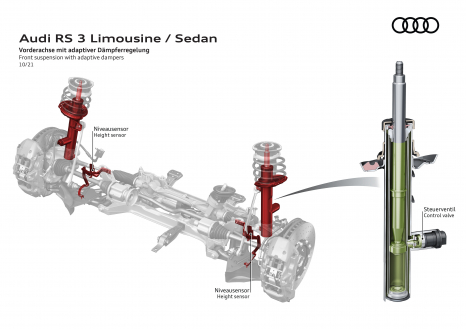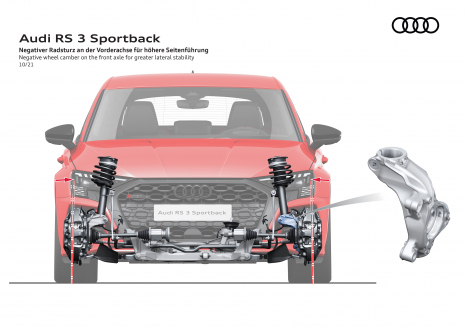Audi RS 3 Sedan – Performance and RS drive select modes
More dynamic ride with greater precision: RS sports suspension and larger wheel camber
The standard RS sports suspension features newly developed shock absorbers and a valve system both specific to the RS 32. The valves ensure that the shock absorbers exhibit a particularly sensitive response as part of the rebound and compression characteristics. This allows the suspension to respond to the respective driving situation even faster and more effectively. The RS sport suspension plus with adaptive damper control is available as an option. It continuously and individually adjusts each shock absorber to the road conditions, the driving situation, and the mode selected in Audi drive select. The three characteristic curves comfortable, balanced, and sporty provide a clearly perceptible spread of the shock absorber characteristics.
The larger wheel camber, i.e. the wheels are angled more toward the road, results in a more precise steering response and increased cornering force. Compared to the Audi A3, the wheels on the front axle of the new RS 32 have just under one degree of additional negative camber. To achieve this, the pivot bearings were modified and the lower wishbones were equipped with stiffer bearings, subframes, and stabilizers. A rear axle features a four-link design with separate spring/damper arrangement, subframe, and tubular stabilizer bar. The wheel carriers, which are stiffer than those of the Audi A3 and S35, absorb the increased lateral forces generated by the torque splitter. The negative wheel camber here is almost half a degree more compared to the A3. The RS specific progressive steering varies the gear ratio depending on the steering angle – as the steering angle increases, the gear ratio becomes smaller and steering more direct. It also assists based on speed and can be varied via Audi drive select. The setup of the springs and shock absorbers is markedly stiff, and the body is ten millimeters lower than on the S35 and 25 millimeters lower than on the A3.
Another new addition to the RS 32 is the modular vehicle dynamics controller (mVDC). This central system captures data from all the components relevant to lateral dynamics, thus ensuring that they interact more precisely and more quickly. The mVDC synchronizes the torque splitter, adaptive dampers, and wheel-selective torque control for precise steering and handling. All in all, it increases the vehicle’s agility, especially on winding roads.
10/2021

